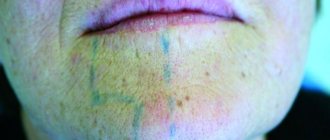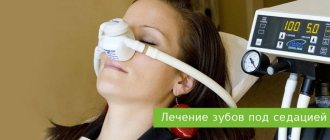For many years, dental treatment was accompanied by pain or discomfort. All this contributed to the development of a great fear of going to the dental office. People have become so afraid of doctors that they are ready to risk their health by testing dubious traditional methods on themselves just to avoid going to an appointment.
Pain and discomfort can be completely eliminated with the help of anesthesia; it is usually used when pain cannot be tolerated. But the injection or drip itself is not very pleasant, and it takes a long time to recover from anesthesia.
Therefore, local anesthesia has become the most common method of relieving pain during a session. The method of pain relief and the drug itself are constantly being improved, and this allows dentists to keep control over the patient’s sensation and condition and select an effective remedy individually for each person.
What determines the level of pain during dental treatment?
If the word “treatment” means not only the common procedure of filling teeth, then not all doctor’s manipulations in the oral cavity cause pain. For example, here is a list of completely painless procedures:
- Treatment of shallow caries.
- Whitening tooth enamel.
- Professional teeth cleaning with AirFlow.
- Deep fluoridation of teeth.
- Fissure sealing.
Most of the above procedures are preventive. Thus, it becomes clear that if you visit the dentist solely to prevent disease, there will be no need for painful procedures.
In other cases, the appearance and degree of pain will depend on the following factors:
- Individual sensitivity and pain threshold of the patient.
- The degree of tooth damage.
- The presence of inflammation, including purulent.
- Individual features of anatomy (location of the nerve ending close to the surface of the tooth, etc.).
- Susceptibility to anesthetic.
- Emotional mood before treatment.
Enamel is the least sensitive, but the more damaged it is, the more susceptible the tooth is to pain. Below the level of the gum, the neck of the tooth does not have enamel, it consists of “cement”; therefore, any dental manipulation in the lower part of the tooth will be accompanied by severe pain.
You should know that without anesthesia it is impossible to cure pulpitis in any form, since the area of its damage consists of nerve and vascular fibers.
Is it possible to have a painless injection?
Most patients, even when performing a simple filling, ask for an anesthetic injection to stop experiencing fear of sudden pain. But such an injection in itself is quite unpleasant. To reduce the pain from an injection, doctors use:
- Special carpule syringes with thin needles.
- Before the injection, the mucous part is dried with a dental hair dryer so that penetration is painless.
- The injection site is treated with anesthetic ointment or gel.
- The medicine is administered very slowly, so after the first dose is administered, the patient will not feel the second.
Important!
Dental treatment under sedation, which requires the use of sedatives, must be carried out with the participation of an anesthesiologist-resuscitator. It is he who performs the sedation and he is also responsible for it. This qualified specialist continuously monitors the functioning of the vital systems and functions of the patient’s body (heart rate, breathing, blood pressure), controls the depth of immersion in sleep and is responsible for the patient’s exit from this sleep. A clear and competent approach to such a serious procedure allows even a child to fearlessly treat teeth under general anesthesia, if indicated. Before starting dental treatment under sedation for adults and children, the doctor consults the patient and then examines him for the presence of allergic reactions.
Types of anesthesia
Methods and painkillers differ significantly in the mechanism of action and the method of administration into the body. The following types of anesthesia are used in the field of therapeutic dentistry:
- Application – involves applying a special gel or spray based on an antiseptic. It is used at the site of an anesthetic injection, removal of dental plaque and when removing baby teeth.
- Infiltration - introducing a dose of anesthetic into the gum tissue by injection. With this injection, the nerve endings are completely blocked. The teeth and adjacent tissues completely lose their sensitivity. Under such anesthesia, it is possible to treat almost any dental disease and even perform minor operations.
- Conduction - this type of anesthesia involves delivering the drug directly to the branch of the trigeminal dental nerve, which blocks the transmission of impulses along the entire length of the nerve. This method is used in areas of dense bone formations of the lower jaw, because it is impossible to administer a direct injection into this area due to the insufficient width of the open mouth. The technique of performing conduction anesthesia is quite complex, and in itself can be painful, but it provides the longest and most lasting effect in the treatment of the lower and upper jaw.
Who is indicated for treatment and dental implantation under general anesthesia?
Dentists resort to dental treatment during sleep in cases of intolerance to local painkillers and their ineffectiveness, in cases of dental phobia and an increased gag reflex in the patient.
General anesthesia in dental practice can be inhalational or intravenous. During inhalation, the patient is put into a state of medicated sleep using a gas-narcotic mixture supplied through an inhalation mask. This type of anesthesia is safer than intravenous. But even this should not be used for longer than 1.5 hours.
Dental treatment during sleep for children and adults is contraindicated in cases of pneumonia, acute liver diseases, catarrh of the upper respiratory tract, and even nasal congestion.
Treatment with laser
The laser has found its use in many industries, but it is especially popular in medicine. Initially, the laser was used for operations as a replacement for a surgical scalpel. Now modern clinics use it for dental treatment. The laser works completely painlessly, and is actively used in the treatment of canals and root cysts, gum problems, and diseases of the mucous membrane.
A typical laser therapy session looks like this:
- The dentist conducts a detailed scan of each tooth for caries, using a laser to identify even damaged areas on the tooth surface that are invisible to the eye.
- The identified problem areas are then treated, with the beam targeting only the caries-affected areas with surgical precision, providing antibacterial cleaning to healthy teeth to prevent accidental infection of a healthy tooth.
- Next, the tooth is washed, treated with an adhesive system and sealed with high quality cement mortar, the composition of which is similar to the composition of a real tooth.
Treatment of dental canals without pain is carried out according to a standard protocol, and a laser beam is used for thorough cleaning of the canals and their antiseptic treatment. Under the action of a dental laser, all liquid instantly evaporates, thus the canals are completely cleaned of pulp, bacteria and other inorganic particles that got on the tooth during the procedure.
Benefits of laser dental treatment:
- Complete absence of pain, discomfort and fear during treatment.
- There is no need to wait until the painkillers take effect.
- The laser treatment procedure is many times faster than treatment with the classical method.
- Gentle treatment of the tooth surface.
- Complete elimination of the possibility of secondary caries
- Prevention of bleeding during treatment in the gingival cavities.
- Complete cleaning of dental canals and no complications
Flaws:
- Only superficial and medium caries can be treated with laser
- High cost of treatment due to the high cost of equipment.
- Physicians must have appropriate qualifications in handling such a device.
General anesthesia in dentistry
Many have already appreciated the convenience of dental treatment under general anesthesia. After all, the result is completely justified, and besides, it doesn’t hurt! But it is important to realize that general anesthesia is not a magic pill; it is not at all harmless to human health. Each anesthesia puts the body in a state of extreme stress. In addition, adrenaline is often added to the anesthetic, which further narrows the capillaries in order to achieve a prolonged effect of the drug. This entails the development of tachycardia, which is extremely undesirable for patients with cardiac problems. Sometimes treatment and dental prosthetics under general anesthesia causes a surge in pressure or severe vascular spasm.
Sedation in dentistry: cost of treatment
Complex dental implantation under xenon will cost from 15,000 rubles, dental treatment – from 5,000 rubles. Compared to general anesthesia, which will also help cope with fear and panic, xenon sedation is a more economical option. At the same time, the quality and safety of the drug have been time-tested and do not require lengthy preparation for the procedure and the presence of a professional team of anesthesiologists and resuscitators next to the patient. Only one accredited specialist is enough. And within 5 minutes after turning off the inhalation unit, the patient gains clarity of thinking and immediately enjoys a new smile.
Anesthesia or sedation?
Classical anesthesia is a complex, expensive procedure that requires the involvement of experienced anesthesiologists and has a number of contraindications. Some clinics do not use it due to the lack of a special license for the use of anesthesia. The main pharmacological drugs used for anesthesia are new generation drugs, including hypnotics, opiates and muscle relaxants. Thanks to them, the patient is temporarily plunged into an unconscious state and completely falls out of the therapeutic process. This is what makes general anesthesia so attractive.
The most advanced modern clinics practice treatment and extraction of teeth under sedation (sedative anesthesia). Sedated patients are in a state of sleep, but there is no loss of consciousness. While in a state of sedation, the patient does not feel pain, does not experience fear or anxiety, but at the same time he retains all reflexes. With sedation, side effects are observed much less frequently than with general anesthesia. An excellent effect is achieved by combining local anesthetics with sedatives. An interesting feature of sedation is that after it, most patients do not remember anything - neither the operation itself, nor the doctors, nor other details.
Complications after general anesthesia –
Modern drugs for putting the patient to sleep, as well as the most modern anesthesiological equipment that allows monitoring heart function and blood pressure, allow us to assert that anesthesia is now as safe as local anesthesia. At least statistics show the same frequency of complications with these types of pain relief. We have already said that in dentistry, sedation is used much more often than anesthesia. Moreover, there is no mortality from sedation at all.
After completing sedation, patients become fully functional within a very short period of time. In this regard, full-fledged intravenous and inhalation anesthesia, of course, has a large number of side effects and complications. Complications during anesthesia are cardiac arrest (as a result of an overdose of an anesthetic drug or diseases of the cardiovascular system), respiratory depression and arrest, as well as vomiting.
But these complications are extremely rare, because Nowadays, modern equipment for monitoring the patient’s condition is almost universally used, allowing an adequate and rapid response to changes in the patient’s condition. In addition, after recovery from anesthesia, dizziness, development of phlebitis and thrombophlebitis, decreased blood pressure, decreased heart rate, hallucinations, neuromuscular excitation, nausea and vomiting may be observed. We hope that our article on the topic: Treatment and extraction of teeth under general anesthesia was useful to you!
Sources:
1. Dental education of the author of the article, 2. Based on personal experience as a dentist, 3. National Library of Medicine (USA), 4. “General anesthesia and sedation in pediatric dentistry” (Stosh V.), 5. “Dental care for young children under general anesthesia” (Kiselnikova L.P.).
Why you should trust us
- full control of the patient’s condition at all stages of treatment - monitoring of vital health indicators is carried out,
- use of high-quality drugs for both general anesthesia and sedation,
- certified doctors with extensive experience in performing such procedures.
Expert opinion
Nikolay Vladimirovich Namdakov Maxillofacial surgeon, implantologist, orthopedist Work experience 18+
“Our clinics offer various options for pain management - from classic “freezing” to sedation and general anesthesia. This allows both doctors and patients not to feel discomfort during treatment. General anesthesia in the clinic is carried out under the supervision of a licensed team of anesthesiologists and resuscitators. Such anesthesia is more expensive, but we must make the procedure as safe as possible for our patients. Sedation involves a milder effect - we have all the necessary equipment to carry it out, and the clinic’s specialists have undergone special training and have valid certificates.”
Disadvantages of treatment under general anesthesia and sedation
With a professional approach and high-quality training, taking into account all possible restrictions and contraindications, treatment under general anesthesia or sedation will not cause any harm. Naturally, the risk of individual intolerance remains, however, precisely for these purposes, in our clinic, manipulations are carried out under the supervision of experienced anesthesiologists and resuscitators.
What to choose - anesthesia or sedation, first of all, you need to decide based on the indications. If conventional local anesthesia is not enough, then at the treatment planning stage, the attending physician will discuss which anesthesia option is right for you. Taking into account health as well as personal preferences. For example, some patients are categorically against a slightly “foggy” creation when using xenon, so after passing all the necessary tests they boldly decide to undergo general anesthesia in dentistry.










